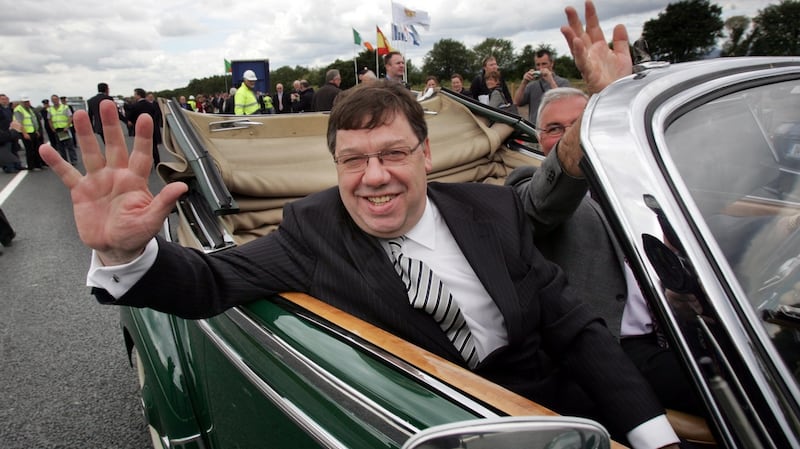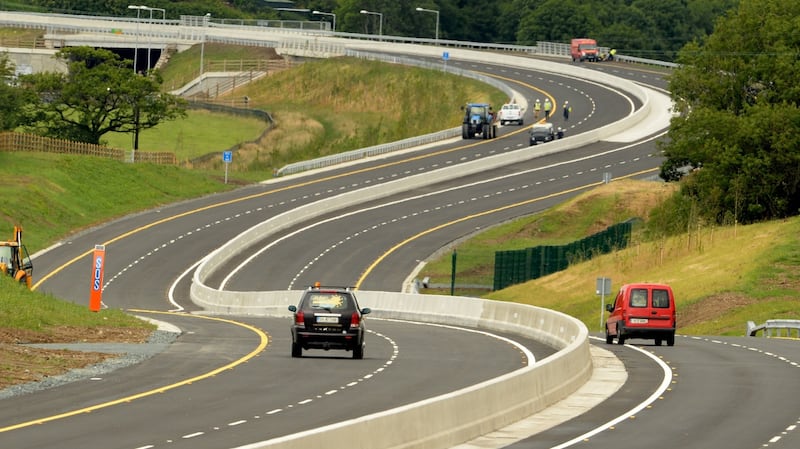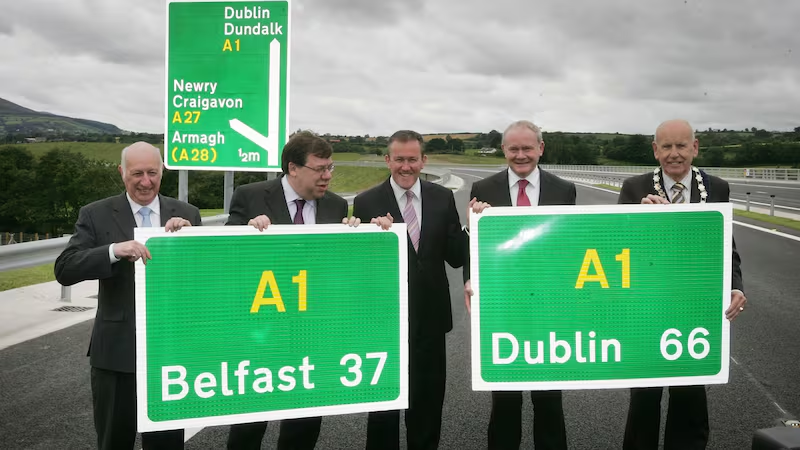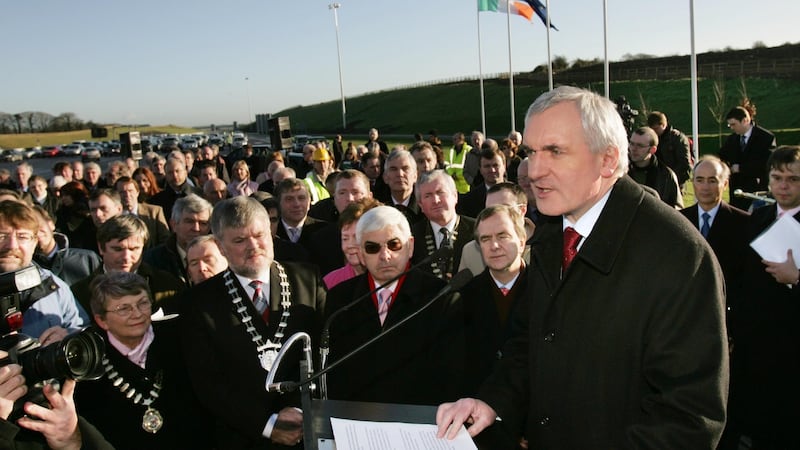Sitting in a control room in East Wall in Dublin, Kevin O'Rourke and his team watch on a bank of screens as a car leaving Dublin Port slows to a stop in the tunnel, pulling into a narrow lay-by.
It could be a breakdown. Everyone holds their breath, hoping the driver stays in the car. However, O’Rourke’s worst fears are realised when the car door opens.
Lorries, some of them fuel-tankers travelling at the maximum 80km/h, are inches away from the motorist. If the driver walks out or simply frightens a lorry driver, the result could be catastrophic.
It is one of the many silly things drivers do. Immediately, the tunnel is closed to incoming traffic. An emergency crew rushes to the scene, and the problem is sorted.
Years into his job as head of network operations with State road builder Transport Infrastructure Ireland (TII), O’Rourke is now seldom surprised at the things people do in cars.
Ireland’s motorways have been a work in progress since the early 1980s, when the once-notorious traffic black spot that was Naas in Co Kildare was bypassed.
However, the first non-stop motorway between major cities – the 194km M4/M6 linking Dublin and Galway – is just a decade old later this year, although parts of it, including the Athlone bypass, remain designated an N or national route.
Motorways to remaining cities and the Border were opened the following year.
Travel times were dramatically reduced. Bottlenecks such as Abbeyleix, Enfield, Craughwell and Drogheda began to disappear from the traffic reports.

Dublin to Galway could be driven in two hours. In the past it could have taken more than four. So, too, could Dublin-Waterford and Dublin-Limerick. Cork was brought within three hours’ reach.
Northern Ireland was brought within an hour of Dublin. Belfast could be reached in two. By 2014 the Newlands Cross flyover was installed, meaning journeys between Cork and Belfast could be made without meeting a traffic light.
It is a long way from the days when conversations about roadworks had to be negotiated with any number of the 30-plus local authorities.
"We needed to stop doing bits of roadways," says former taoiseach Bertie Ahern, who is still proud of the motorway projects carried out during his term in office. "Economic development had been held back for two reasons: one, the conflict in the North, and the second our infrastructure was useless," he says.
“We had to get the roads authority in place so we could do a deal with the local authorities en bloc,” says Ahern. “Second, we had to deal with the Irish Farmers’ Association so we could get the land en bloc.”
While piecemeal, annual budgets to local authorities had to be dropped, he says. Instead, money had to put aside for multi-annual budgeting “so we could get proper contracts” and to attract in the major international road-builders needed for the bigger jobs.
“The Spanish had done a great job on their roads programme. We brought them over and we listened to what they did ... and then we got on with it,” says Ahern.
The price of expansion
Academic PJ Howell, a director of services in Fingal County Council, has charted the development of Ireland's roads programme over 40 years.
He says the improvements until 1993, such as they were, were carried out in dribs and drabs until the National Roads Authority was created in 1993, and its publication five years later of the Road Needs Study.
Then, Howell notes, the National Roads Authority set out a schedule of road improvement needs on national routes over 20 years until 2019.
It contributed significantly to the National Development Plan 2000-2006, when Ahern singled out motorways from Dublin to other main cities and the Border for priority.
Everything could be done for €6 billion, it was then believed. However, the list was extended to include €1 billion for the M3 motorway; €630 million for the M17/M18 works between Crusheen and Tuam; €1 billion for improvements to the M50 and €660 million for the Shannon Tunnel. There were others.
Foreshadowing rows about the cost of the national children’s hospital, the then comptroller and auditor general, John Purcell, warned in 2004 that the roads programme would cost €16.4 billion.
The National Roads Authority was irked, arguing that the Primary Roads Improvement Programme and the one covering the construction of the motorways were vastly different beasts, and the costs of the former were frequently applied to the latter.
Looking back, Ahern says the motorways, allowing for punt-euro conversions and some changes to designs, had been priced at €7 billion, and came in under €10 billion, 10 years later.
The challenges were not just financial. Noel Dempsey, minister for the environment from 1997 to 2002, remembers that the Pollardstown snail, Angistora Vertiego, emerged as the focal point for opposition to the €60 million Kildare bypass.
However, Tony Lowes, then chairman of An Taisce's Natural Environment Group, said that although the snail had become something of a rallying issue for both sides, it was "a bit of a red herring".
“This is not just about one species. It is about the whole ecology of the fen. It will decrease the flow of water and the flora and fauna in this site, one of the country’s most important sites.”
In granting permission for the road, Dempsey ordered that it would not drain into the surrounding land – a process known as “tanking”, then used for the first time in Ireland.
Hill of Tara controversy
The motorways programme became more controversial after Fianna Fáil joined with the Greens in 2007, since the latter were implacably opposed to the building of the M3, which passed close to the Hill of Tara in Co Meath.
Dempsey was charged with negotiating the programme for government, but he rubbishes the myth that the Green Party delayed entering government until the M3 was signed off by outgoing minister for the environment Dick Roche so they could avoid blame from their supporters.
"No, not true," says, Dempsey, who says the Green Party's John Gormley tried very hard to block the M3. "He was insistent on three issues: the M3, a ban on stag hunting and a ban on fur farming."
Negotiations became heated.
Ten years on Gerard Brady, head of tax and fiscal policy at Ibec, believes the improved journey times offered by the motorways has increased productivity by 0.35 per cent.
“This might seem small,” he says . However, he notes it is comparable to “the impact of industrial robotics over the past 20 years or the impact of railroads in the 19th century and the US highways in the 20th century”.
However, better roads have brought more traffic. Traffic counters on the M50 near Blanchardstown recorded 80,000 vehicles a day in 2000. This year those same counters will record 150,000 vehicles – a third of that increase has come since 2012 as the Irish economy recovered after the economic crash.
Direct comparisons for traffic numbers outside of Dublin are harder to find. Most local authorities are unable to produce data from 20 years ago. “[The counting system] that was there before the motorways was rubbish and most of it didn’t work,” says one source in the data collecting industry. “Nobody kept records for long.”

However, there are some telling statistics from the CSO Traffic Omnibus. In 2013, 100 million tonnes of freight was carried on Irish roads. Two years ago that number had increased to 147.2 million tonnes. Last year it breached 150 million tonnes, official statistics are soon expected to say.
Meanwhile, traffic at the Dublin end of the motorway network increased by an average of 4.3 per cent a year between 2015 and last year, according to TII.
Measured in deaths
The most telling statistic, however, is not reflected by traffic volumes, but rather by deaths.
Three-quarters of road deaths today, according to the latest figures from the Road Safety Authority, take place on rural roads, a fifth occur on urban roads. Just one in 25 occur on motorways.
“Statistically, the motorways and dual carriageways are our safest roads,” says one road safety expert.

The motorways have also changed the commercial face of Ireland. Sitting in her cafe in Abbeyleix, Co Laois, Marie Quinn remembers that she had to let staff go after the M8 motorway opened in May 2010.
Also affected were Urlingford, Cashel, Mitchelstown, Fermoy, Watergrasshill and Glanmire. On routes to Waterford, Limerick, Galway and the Border, many towns found themselves facing a new, quieter reality.
"You see the faces coming back now. It was a shock, but it was a readjustment," says Quinn, whose neighbour, Tom Lennon, of Morrissey's pub on Abbeyleix's Main Street, saw "a big fall-off" too.
However, Morrissey’s, facing competition from what Lennon calls the “new villages” – the motorway services – has fought back.
Pointing to his Bushmills Restaurant of the Year Award 2017, Lennon says the motorway stop-offs are all about “high carbs and fuel”. Motorway cafes give people very little choice, he says.
The tension between towns and motorway services was illustrated when the Gort to Tuam section of the “Atlantic corridor” opened in May 2017.
Then, The Irish Times pointed out that this created a 101km road from Ennis to Tuam that had no services whatsoever. Businesses in Gort were quick to point out the town was still there, with many attractions a short drive from the new motorway.
Motorway services are an area where TII has not covered itself in glory.
In 2009 the first contract for the initial tranche of motorway services was awarded to the Superstop consortium to operate at Castlebellingham and Lusk on the M1, and at Enfield on the M4. TII has not opened a motorway services area since, hoping that the private sector would take up the initiative.
Supermac's founder Pat McDonagh, who is developing a series of plaza services, including the best-known one – named after Barack Obama – in Co Offaly, is not impressed with TII's position, pointing out that it lobbied Clare County Council against his proposed development in Ennis.
Taking a toll
The State road builder has been more successful in its toll business. Revenue has recently agreed to begin repaying it €100 million in VAT it deemed was due, and collected, on the State-owned tolls. TII paid the money under protest, arguing that State-owned tolls should not charge VAT and won its case at the European Court of Justice.
However, the Department of Transport has in recent years dramatically reduced the roads maintenance grant paid to TII, which led to complaints at the Oireachtas Committee on Transport by the body's chief executive Michael Nolan.
TII, he said, will at best be able to fund 70 out of a promised 150 minor road safety schemes in the Road Safety Strategy 2013-2020, due to an overall shortfall in funding of €600 million.
However, tolls remain good business. Two years ago TII harvested €175 million, with €145 million of that coming from the M50. This is expected to rise to €150 million this year.
In the future, tolls could be placed at multiple points along the M50, to harvest tolls from those who currently enjoy much of its benefit without paying for it because they do not cross over the Liffey.
Supporters argue that such charges would be fairer. However, every minister for transport in the past decade has demurred, saying that should not happen until public transport improves.
If it were done now, however, multiple-point tolling would simply drive traffic off the motorway and back to pre-M50 days when suburb after suburb was crowded with car traffic.
TII will be €50 million a year better off when its payments for the West-Link bridge run out in in March 2020, though it is likely that its State grant for road maintenance will fall to match its windfall gains.
Missing links
Ten years on, however, Ireland’s motorways network is not yet complete. Last week, consultants were appointed to redesign the proposed €900 million M20 Limerick to Cork motorway.
The previous plan – bypassing Adare, Charleville, Buttevant and Mallow, but with a link road to serve Blarney – was dropped due to the economic crash.
However, Buttevant, Mallow, Charleville and Adare want to be connected, too, and Blarney wants to ensure it does not slip off the list.
PJ McCarthy of Charleville Chamber of Commerce says a link road to the motorway is needed “at the closest possible point” to the north Cork town. Previous designs for an access route to the proposed motorway had not taken the shortest link to the town and this was not acceptable, he says. Large employers such as the Kerry Group in the town need a direct link, he argues.

Tom Sheahan, an auctioneer based in Buttevant, says the town needs a bypass as up to 12,000 vehicles a day go through its centre. He says the town had to "fight tooth and nail" to get a connection to the motorway in the original design.
Adare in Co Limerick is currently being bypassed on its northwest, while the proposed M20 is likely to run on the southeast of Adare, from Patrickswell towards Charleville. It, too, needs a link if the town is to capitalise on tourism and plans by Adare Manor to attract the Ryder Cup in 2026, says Limerick Senator Kieran O'Donnell of Fine Gael.
Meanwhile, John Mc Donnell of Mallow Development Partnership says the town has already been promised a ring road, to be opened by 2023.
This plan cannot be delayed until the M20 is built, because that will not happen until 2027. However, it too will need a link to the M20 because the ring road would link the Dublin and Waterford roads to the Limerick road. Such connectivity is particularly important to Dairygold, which is based in the town and was a significant employer, he adds.
However, planners want as few off-shoots as possible from the motorway, believing that major urban development should be concentrated in as few places as possible.
Elsewhere, business and development groups in Kerry, Mayo and Donegal are calling for motorways – or at least dual carriageways – to finally reach them.
Besides the M20, the National Development Plan lists 12 major road schemes estimated to cost €900 million, along with the €600 million Galway city ring road.
Environmental concerns
Environmentalists and climate-change campaigners want the focus taken away from motorways and turned to public transport.
Friends of the Irish Environment has already taken a case against the Government, arguing that the National Development Plan should have been subjected to robust climate change, emissions and environmental checks.
In the High Court in January it argued that the Government had reneged on pledges to the EU. "Every single decision the Government make is supposed to be climate-proofed. But we can't make them do that, we despair," complained Tony Lowe.
Describing the pre-occupation with roads as “disturbing”, the Green Party’s David Healy cited delays with the reopening of the Dublin-Navan railway line, which was first mooted in 2005 but was then put on the back-burner.
Oisin Coughlan of Friends of the Earth says the emphasis in Government seems to be on "two-thirds private transport to one-third public", when it should be the other way round.
However, little of this will find support in the regions. Kerry Fianna Fáil TD John Brassil argues that stopping motorway building before it reaches the west would be to place remote districts at a competitive and productive disadvantage.














